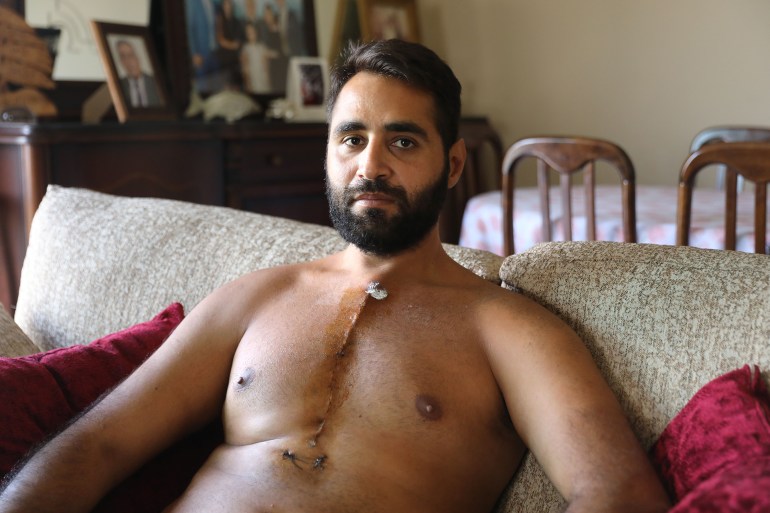The last thing that young Firas Hamdan expected was that his participation in an angry demonstration in central Beirut would end after the terrible explosion of the port, with an open-heart operation, as a result of his being hit by a blowhole, and the same was true for Zeina, who had not yet understood why she was injured by two explosive bullets while she was protesting peacefully.
Days after the explosion, which occurred on the fourth of this month, thousands of Lebanese took to the streets, carrying their anger and carrying officials at all levels as a result of negligence, corruption and negligence, which led to the Nakba of the port, and confrontations took place between the demonstrators and the security forces.
During the following days, doctors reported that they saw dozens of people who were injured during these confrontations, with severe injuries close-up, unusual since the protests against the political class began last fall. Human rights organizations accused the security forces and armed men in civilian clothes of firing metal balls and rubber bullets with the aim of "causing harm."
Lawyer Firas Hamdan (33 years old) used to document - as part of his work in the Committee for the Defense of Protesters in the Beirut Bar Association - the violations that protesters are subjected to, and follow up the files of the injured or those who are arrested. He was injured after a bomb was thrown in an angry crowd on the eighth of this month, when he was broadcasting live on his Facebook page.
Firas - who suffers from a vertical wound in his chest and prevents him from moving easily - tells of how he was "injured, and after a minute and a half I lost consciousness," adding, "Khurdaja entered my heart and is still there." He continues, "The doctor told me: If you want to extract it, this means that I will kill you."
The first thing that came to Firas's mind after his injury was a question: "Why do I live here and what have I done?" However, his sense of bitterness was short-lived, as he realized that "the confrontation is difficult with a deep-rooted authority," and "disconnected from reality."
"It is an attempt to kill people and discipline them ... I will stay at home for a month or more, and then I will go back to the street and raise the same demands, but with greater ferocity and conviction," he says.
Firas has to see his doctor after two weeks to assess the side effects, and if the body will adapt to the pallet remaining in the heart.
The explosion in the port resulted in 181 dead and more than 6 thousand injured, and caused severe damage to the neighborhoods of the capital, displacing about 300 thousand of its residents, and - according to the authorities - a fire in a warehouse in which huge quantities of ammonium nitrate were stored 6 years ago.
The demonstrations continued for 4 days, and were interspersed with attempts by the demonstrators to approach Parliament, where most of the injured were injured.
She was sniped and
in the vicinity of Parliament, Zeina (50 years old) - which is a pseudonym - was standing among the demonstrators, whom the security forces tried to drive away by firing tear gas. She recounts that she stood in her place, waiting for the crowd to disperse to avoid any harm.
"Suddenly, I felt that I was hit in the back," she told France Presse. "I took two steps before I felt another pain in my hand. Then I fell to the ground."
Zina - a mother of 3 children, who has been participating in the demonstrations since their inception - was hit by two bullets that exploded after they entered her body, and the pellets branched from them.
"I was sniped, I do not know who fired because we did not see security forces near us," she says indignantly, adding, "I consider it an attempt to kill."
And a group of doctors - which calls itself the "white shirts" - spoke at a press conference last week about the injury of dozens of citizens in their eyes, chests and faces, or even in the skull of the head and heart.
One of the group members, Doctor Salim Nasser, explained to France Press, "Since the eighth of this month, we have found, in addition to rubber bullets, the use of bullets" from "close range and intensity", which "caused severe injuries because it tore and penetrated the skin."
Shot can have "side effects" such as poisoning and chronic fatigue, and if it moves in the bloodstream, it can cause a stroke, according to Nasser.
Doctors counted 40 injuries in different parts of the body in Beirut hospitals, in addition to about 20 direct injuries in the eyes.
Ophthalmologist Nada Jabbour explains that 8 of the injured in their eyes "were injured in a way that required surgical intervention in the operating room, while 3 others lost an eye."
Judicial complaints
Amnesty International documented in the report “tear gas, rubber bullets and metal pellets from automatic feeding rifles were fired indiscriminately into crowds”.
She said that "the Lebanese army and security forces, in addition to unidentified men in civilian clothes, shot" at unarmed people, indicating that "the authorities aimed to punish the protesters." And it demanded a "thorough investigation" with all those responsible.
Both the Internal Security Forces and the Lebanese Army Command denied firing live bullets at the demonstrators.
Lawyer Imad Ammar, a member of the Protesters Defense Committee at the Beirut Bar Association, says, "We are in the process of submitting complaints to the judiciary in the name of the injured," to demand "clarifying the identity of the attackers and holding them accountable."
And he confirms that the documented injuries "have not been reported before, including live ammunition, and some with shotguns fired from rifles, grenades scattered, or bullets."

